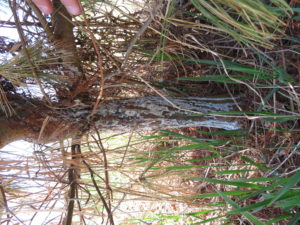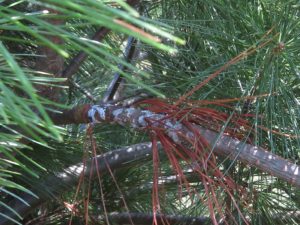
On this white pine, you can see on the lower left a branch recently killed by blister rust; on the lower right is a branch that is slightly off-color. The off-color branch also had a canker but it had not yet completely girdled the branch. Photo: Linda Williams
By Linda Williams, forest health specialist, Woodruff. Linda.Williams@wisconsin.gov; 715-356-5211 x232
White pine blister rust is a fungus that causes cankers on white pine. The cankers can girdle and kill branches or the main stem of the tree. White pine blister rust infections create “dead spots” or cankers that continue to expand each year on the branches or main stem. Eventually, orange pustules develop which erupt around the edges of the canker; this is how the fungus reproduces.
White pine blister rust, although specific to white pine, cannot be transmitted directly from one tree to another, instead requiring a secondary host. Spores produced on white pine can only infect Ribes (gooseberry) plants, which will then produce spores later in the summer. Spores from Ribes plants will then infect white pine trees, providing weather conditions are just right. Blister rust spores must first infect a needle, and then grow into the branch or main stem. Since white pine seedlings and saplings often have needles attached directly to the main stem, the fungus can gain entry directly into the main stem of the tree. Damage from a girdling canker may take years to become severe enough to cause tree decline and mortality.
Pruning branches that are infected with blister rust present can prevent the disease from growing down the branch and into the main stem, where it could eventually girdle the tree. Branches with cankers can be easy to spot; just look for a branch that is pale green compared to the rest of the tree, or, if the branch has just died, it will be a rusty red color that stands out from the rest of the tree. Young trees that are infected near the ground may not be killed until they’re 6-8 years old. Watch for whole trees that are turning off-color, and check the base for sunken areas or areas with lots of pitch flow which could indicate a canker at the base of the tree.

Orange pustules erupt from the canker to produce spores that will infect the secondary host Ribes (gooseberry). Photo: Linda Williams

A blister rust canker at the base of the tree will look sunken in like an hourglass, and create a lot of pitch flow. Photo: Linda Williams

A blister rust canker on the branch will be sunken or misshapen as well as have pitch oozing from it. Photo: Linda Williams
